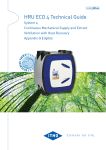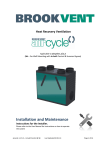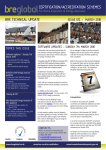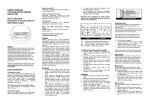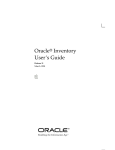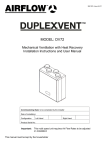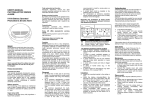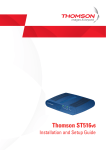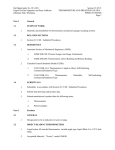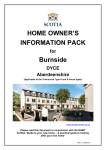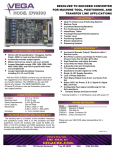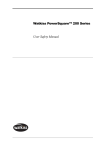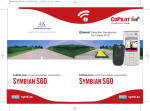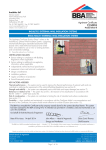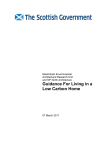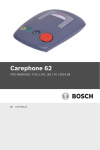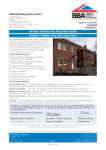Download Cent LoCarbTech 16pp
Transcript
Off-Site February 2008 Kingspan Air Recovery Unit System 4 – Continuous Mechanical Supply & Extract Ventilation with Heat Recovery – Appendix Q Eligible Low Energy - Low Carbon Buildings Contents Introduction Design Service Technical Specification Dimensions Building Regulations 2 10 12 14 16 Introduction The Kingspan Air-Recovery unit is a high efficiency heat recovery unit. It has a sophisticated counter-flow heat exchanger which can recover up to 91% of the heat from the discharged air. When required, the recovered heat is used to pre-heat the fresh air being brought in from outside. 2 3 Introduction Kingspan unit Dwellings The units for houses and apartments have the same basic design. The difference is in the layout of the duct connections and motor modules. For houses, the air supply is situated at the bottom of the unit and for apartments the air supply is on the top part. The motor module seals the unused connection. The connections on both the top and bottom can be used for air extract. Unused connections are sealed with a cap. As a result of the Kingspan Air-Recovery unit's unique patented clamp construction the sealing of the elements is optimised. Therefore, there will be no internal or external leakage. The unit can be easily reversed when dwelling designs are mirrored. Weight As a result of the unique clamping construction in combination with the plastic / synthetic elements, the weight of the Kingspan Air-Recovery unit is only 25 kg. Exhaust & Supply Connections Application All exhaust and supply connections have 150 mm internal diameter and 180 mm external. The connections allow the direct attachment of modular plastic and metal duct accessories. Each connection is stamped with an embossed indicator that shows the direction and source of the air. The Kingspan Air-Recovery unit is ideal for all new build dwellings – especially those being built with a high standard of air-tightness. Description Counter-Flow Heat Exchanger Kingspan Air-Recovery is a high efficiency heat recovery unit. It has a sophisticated counter-flow heat exchanger which can recover up to 91% of the heat from the discharged air. When required, the recovered heat is used to pre-heat the fresh air being brought in from outside. The unique heat exchanger works on the principle of counter flow. One of the characteristics of this is that the incoming and outgoing air moves via triangular canals. Each canal is surrounded by further canals where the flow of air is in the opposite direction. This creates an enormous surface area in which to exchange heat. This is one of the reasons why up to 91% thermal efficiency can be reached. Models The table below lists the models available. 4 Introduction 100% Summer Bypass Valve Frost Protection Device The heat recovery unit has an integrated summer bypass valve. The bypass valve diverts all the exiting air supply around the heat exchanger. This means the exiting air from the dwelling does not heat the incoming fresh air when the bypass valve is activated. To prevent the heat exchanger from freezing, the Kingspan Air-Recovery unit has an integrated frost protection valve. Motors The Kingspan Air-Recovery unit has two energy efficient DC motors. The impellers have backward curved blades which help to keep it clean – maximising the capacity of the supply and extract fans. Removing the Heat Exchanger 5 Kingspan unit Capacity Setting Appendix Q Eligible In the connection unit of the Kingspan Air-Recovery unit are two potentiometers. These allow for the adjustment of both the low and high speed. The mid position is calculated automatically. The factory setting for high position is 225 m3/h. To ensure the best energy efficiency this potentiometer should not be touched unless the required volumes cannot be reached when room grilles are set in their fully open position. The Kingspan Air-Recovery unit has been tested at BRE and is a certificated Appendix Q Eligible product. The test results, which are available on www.sap-appendixq.org.uk, can be used to help improve SAP ratings. Installing The Kingspan Air-Recovery unit is designed to be installed in various types of dwellings; from small apartments to larger houses. The unit can be placed in different places in the dwelling, such as: Filters The Kingspan Air-Recovery unit has, as standard, two G3 filters. One of the filters is placed between the exhaust duct from the house and the heat exchanger. This filters dust and grease from the exiting air. With less contaminants in the exiting air, the heat exchanger becomes less dirty. • In the loft, in a closed room; • In a closed storage room; and • In an airing cupboard. Mounting The other filter is situated between the fresh air inlet and the heat exchanger. This filter ensures that fresh air is filtered before it is supplied into the dwelling. It also prevents the heat exchanger from becoming dirty. Both filters can be easily removed, cleaned and replaced by the occupant without the need to remove the front cover. The unit must be fixed, with the supplied mounting bracket, to a wall with a mass of at least 200 kg/m2. Access to the Unit The unit should be located so that it can be easily accessed for servicing. To enable easy servicing of the filters and heat exchanger there must be a space of not less than 500 mm in front of the unit. Points of Attention Important To ensure a good installation please pay attention to: Make sure that nothing is placed on top of the automatic frost protection valve. • Moisture resistent insulated exhaust duct to outside (min. internal diam.150 mm). Installation & User Manual • Damp proof thermal isolated fresh air inlet duct from outside (min. internal diam. 150 mm). The installation and user manual are delivered with the unit. Make sure to read these manuals before installing or using the unit. If required the installation manual can be obtained from Kingspan Off-Site prior to delivery of the unit. • Air inlet duct to dwelling min. internal diam. 150 mm, which can be split up in two ducts internal diam. 150 mm. • Exhaust duct from the dwelling min. internal diam. 150 mm. • Apply the provided sound insulating flexible pipe (type FGD 180-50, D=180 mm L=500 mm) between the air supply to the dwelling and the unit. • Condense drain with water seal, replenishable, for a water block between the unit and the place where the unit is mounted and the waste pipe. • Mains supply must be 230V AC. 6 Introduction Introduction Easy access Maintenance The Kingspan Air-Recovery unit requires only minimal maintenance, as follows: New filters are available in sets. Spare parts can easily be exchanged, without tools: • Clean the filters when the dwelling is completed. These filters may be dirty because of building materials; • The filters can be changed without taking the cover off. • The heat exchanger can also be reached by removing the front cover. • Clean filters every six months; • The complete service module (motors, fans, power supply and controls) can be removed or replaced without disconnecting the ducts. • Replace the filters at least once a year; • Clean the heat exchanger every six years; and • Depending on the pollution, also clean the motor and fan blade. • Data can be read by connecting a computer with service software. Warranty The unit has a guarantee of two years frpm date of installation. Accessories A full heat recovery system consists of many different components. The heart is the Kingspan Air-Recovery unit. More information about ducting and other system components can be obtained from Kingspan Off-Site (see rear cover). G4 filter 7 Kingspan unit Electrical Connection The last used switch is the master. Advantages of Wireless Control: The Kingspan Air-Recovery unit can be connected to a 230V 50Hz supply. A flying lead is attached to the unit as standard. When installing the unit, an isolation switch must be fitted with a minimum contact gap of 3 mm. As standard, the electrical connection on the unit is positioned on the left hand side. When the unit is reconfigured for opposite installation the electrical connection will be positioned on the right hand side. • No drilling, fixings or electrical wiring is necessary; • Control from every room is possible; • Additional switches can be added at any time; and • A better indoor climate, by optimal control. Control The Kingspan Air-Recovery unit can be ordered with a choice of optional control units: • Wired 3 step control; and • Wireless (RF) 3 step control unit with timer. Wired 3-way Switch This wired control unit can be connected to the connection box of the unit, see wiring diagram (see page 9). Type RS3i built in RF 3 speed Control RF 3 Speed Controller RF 3 Speed Controller If the heat recovery unit is ordered with a wireless (radio frequency) remote control switch a receiver unit is fitted into the unit during production. The switch, which has a selfadhesive backing, should be located in the wet rooms; most likely the kitchen or bathroom within the house and can be used to change the unit between speed position one, two and three. Additional transmitters are available to allow the fan to be controlled from more rooms; the utility room, en-suites etc. 8 Introduction Installing RF Control Unit Timer Function To install the wireless control switch unit in the kitchen, simply affix the control unit on to a tile with the supplied double sided adhesive tape. Alternatively, the control unit can be mechanically fixed. Each unit is supplied with an installation and user manual. Do not place the wireless control switch on a metal surface. A timer function is also included on the wireless control switch. This timer can be used to switch the ventilation to the highest speed for a period of time, for instance after an occupant has used the bathroom. The advantage of this is that the run-on period of the timer, the fan will revert back to its original speed. Pressing the timer button once will switch the fan to high speed for 10 minutes. Pressing the timer button a second time will switch the unit to high speed for 20 minutes and a third press of the button will switch the unit to high speed for 30 minutes. The timer function can be over-ridden at any time by pressing either of the three speed buttons. Additional Wireless Control Switch Information • Transmission range 100 m in free air. • Transmission indoors is possible through a maximum of two concrete floors. • Pointing of transmitter towards the fan is not necessary. • No external antenna. • Frequency 868 MHz, no licence required. Wiring Diagrams 9 Design Service Kingspan Off-Site's comprehensive design service helps take the stress out of specifying a ventilation system. Offering free technical and design assistance for all aspects of mechanical ventilation, simple sketches and scribbled dimensions can be easily converted into a quotation and a professional plan to save time and hassle. With an in-depth knowledge of current UK Building Regulations (England, Wales, Scotland and Northern & Southern Ireland), all plans are guaranteed to comply with all current legislation. With the ability to both send and receive all plans electronically and manually, this free design service has been specifically developed to help make life easier. 10 11 Design Service Technical Specification *Values to be used in the EPC calculation at 230V, according to NEN5128. Other technical specifications Power supply: 230V Frequency: 50Hz Dimensions: Condensate discharge diameter: 40 mm external Protection: IP31 Filterclass: G3 height 848 mm width 730 mm depth 479 mm 12 Sound Power Spectrum 13 Technical Specification Dimensions Suspension Mirrored Suspension 14 15 Dimensions Building Regulations The 2006 Edition of the UK Building Regulations Approved Document F1: Means of Ventilation (applicable in England and Wales) details four clearly defined systems of ventilation to dwellings. The Kingspan Air-Recovery unit complies with the fourth system 'Continuous Mechanical Supply & Extract with Heat Recovery (MVHR)'. System 4 - Continuous Mechanical Supply & Extract with Heat Recovery requires a “minimum high rate” in each wet room to be achieved (kitchen 13 l/s and both utilities and bathrooms 8 l/s (sanitary only 6 l/s)). In employing this type of system, there is no need to install background ventilators in the dwelling – an ideal solution to “noisy” sites. The system provides quiet, uninterrupted extract ventilation from the dwelling, removing warm stale air via all of the “wet” rooms, creating a permanent air path through the property from the “dry” habitable rooms. Air, drawn into the property by the fan, is routed through an integral high efficiency synthetic heat exchanger where warmth from the extracted air is transferred to the incoming fresh air, before it is supplied to the habitable rooms. The “minimum low rate” is calculated by taking the number of bedrooms in the dwelling and applying the l/s value from Table 1.1B. In addition, the rate should be no less than 0.3 l/s per m² of internal floor area (all storeys) plus, for each additional occupant over and above the anticipated two for the first bedroom and one for each of the others, a further 4 l/s must be added to the extract rate. Also, there is an addition of an allowance to be calculated for air infiltration. 16 Continuous Mechanical Supply & Extract Ventilation with Heat Recovery Continuous Supply and Extract 1. Determine the whole building ventilation rate from Table 1.1B. Allow for infiltration by subtracting for multistorey dwellings: 0.04 x gross internal volume of dwelling heated space (m3) for single storey dwellings: 0.06 x gross internal volume of dwelling heated space (m3). 2. Calculate the whole dwelling extract rate at maximum operation by adding the individual room rates for ‘minimum high rate’ from Table 1.1A. 3. The required air flow rates are as follows: Maximum Extract Rate (boost) is the greater step of 1 and 2 above. The minimum individual room extract rates should be at least those given in Table 1.1A for minimum high rate. Minimum air supply rate should be at least the whole building ventilation rate in 1 above. 4. No background ventilators are required with System 4. In addition, the minimum ventilation rate should not be less than 0.3 l/s per m2 internal floor area (this includes each floor, e.g. for a two-storey building, add the ground and first floor areas). This is based on two occupants in the main bedroom and a single occupant in all other bedrooms. This should be used as the default value. If a greater level of occupancy is expected, then add 4 l/s per occupant. 17 Building Regulations Building Regulations – System 4 As featured in the Energy Saving Trusts’ ‘Demonstrating Compliance - Best Practice’, in order to meet reduced CO2 emission targets, MVHR units have been set certain standards and must have a specific fan power (SFP) of 1.0 W/L/s or less and a heat recovery efficiency of 85% or above. These figures have been both reached and exceeded by the Kingspan Air-Recovery unit. 18 The Kingspan Air-Recovery unit is SAP Appendix Q Eligible proving it to be one of the most energy efficient MVHR units available. Designed to calculate the energy performance of Dwellings, the Standard Assessment Procedure (SAP) Appendix Q website: www.sap-appendixq.org.uk is a UK based Government led initiative used to demonstrate compliance with building regulations within the following areas - Part L (England and Wales), Section 6 (Scotland) and Part F (Northern Ireland), providing energy ratings for dwellings that can be compared nationally. DEAP (Dwellings Energy Assessment Procedure) in Ireland also refers to (SAP) Appendix Q. As featured in the Energy Saving Trusts’ ‘Demonstrating Compliance - Best Practice’, in order to meet reduced CO2 emission targets, MVHR units have been set certain standards and must have a specific fan power (SFP) of 1.0 W/L/s or less and a heat recovery efficiency of 85% or above. These figures have been both reached and exceeded by the Kingspan AirRecovery unit. The Energy Saving Trust’s ‘Best Practice’ standards, along with The Code for Sustainable Homes, both offer valuable guidance toward sustainable home building and offer the industry the chance to exceed Government targets and to aspire to go that extra mile. 19 Building Regulations SAP Appendix Q Eligible The Kingspan Air-Recovery unit is manufactured for Kingspan Off-Site by Itho Ventilation Ltd. Kingspan Off-Site reserves the right to amend product specifications without prior notice. Any information, technical details and fixing instructions, etc., included in this literature are given in good faith and apply to uses described. Recommendations for use should be verified as to the suitability and compliance with actual requirements, specifications and any applicable laws and regulations. For other applications or conditions of use, Kingspan Off-Site offers a technical advisory service the advice of which should be sought for uses of Kingspan Off-Site’s products that are not specifically described herein. Please check that your copy of the literature is current by contacting the Kingspan Off-Site Marketing Department. Kingspan Off-Site Eltisley Road, Great Gransden, Sandy, Bedfordshire, SG19 3AR Tel: 0844 967 0455 Fax: +44 (0) 1767 676 444 Email: [email protected] www.kingspanoffsite.com This brochure is printed on paper made from 80% post-consumer waste and 20% virgin pulp which is Forest Stewardship Council (FSC) certified.






















